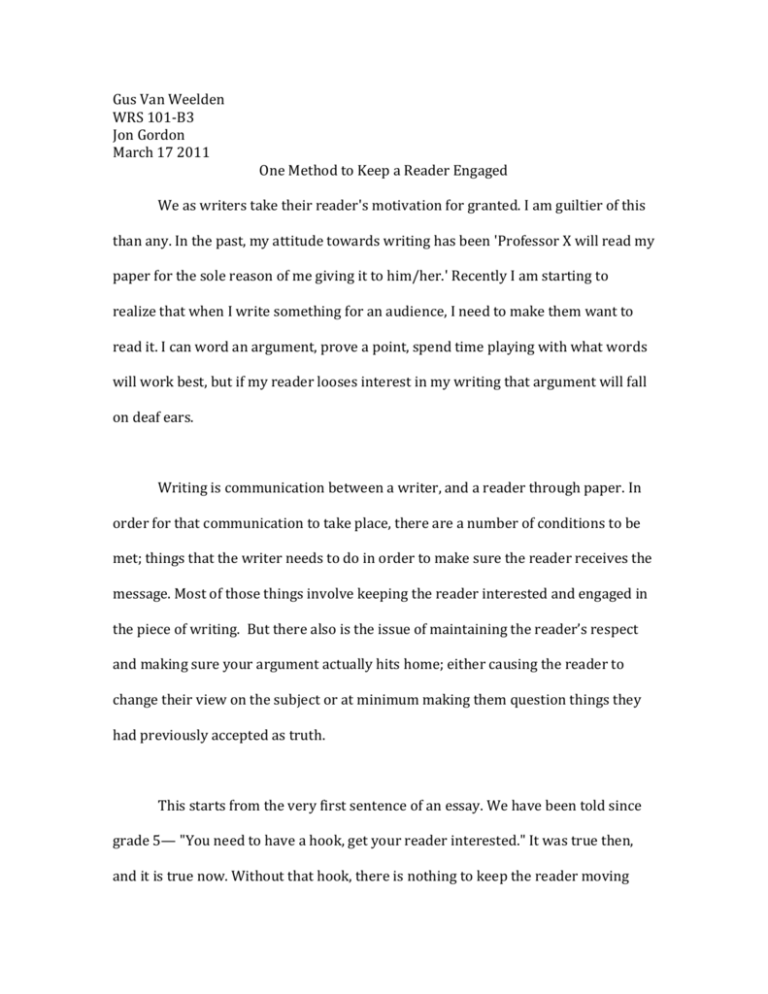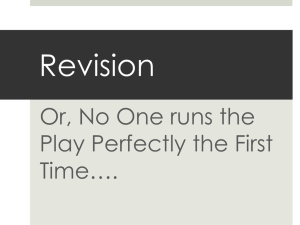essay 2-draft 2
advertisement

Gus Van Weelden WRS 101-B3 Jon Gordon March 17 2011 One Method to Keep a Reader Engaged We as writers take their reader's motivation for granted. I am guiltier of this than any. In the past, my attitude towards writing has been 'Professor X will read my paper for the sole reason of me giving it to him/her.' Recently I am starting to realize that when I write something for an audience, I need to make them want to read it. I can word an argument, prove a point, spend time playing with what words will work best, but if my reader looses interest in my writing that argument will fall on deaf ears. Writing is communication between a writer, and a reader through paper. In order for that communication to take place, there are a number of conditions to be met; things that the writer needs to do in order to make sure the reader receives the message. Most of those things involve keeping the reader interested and engaged in the piece of writing. But there also is the issue of maintaining the reader’s respect and making sure your argument actually hits home; either causing the reader to change their view on the subject or at minimum making them question things they had previously accepted as truth. This starts from the very first sentence of an essay. We have been told since grade 5— "You need to have a hook, get your reader interested." It was true then, and it is true now. Without that hook, there is nothing to keep the reader moving forward. With no motivation to continue, the rhetorical situation ceases to exist and the point the author is trying to make, now is completely lost. What your grade 5 teacher didn't teach you is that a hook at the beginning is not the be all and end all of keeping a reader interested. A great hook might drag a reader through the first few lines, but that initial attention grab does not last long. As writers, we need to keep our reader interested through the whole paper. The main way to accomplish that is to have a storyline— a logic path. There needs to be a thread that runs through the entire paper, stringing the reader along and keeping them waiting for the author to reveal their final answer. A problem I have had in the past is writing a paper that jumps from point to point, all focusing on the same topic, but not acting as a cohesive train of thought. Any major gap in logic is a break in the continuity of the paper and has the potential for your reader to become disinterested. Unless this point of discontinuity is followed by another mindblowing hook, chances are the reader has put the paper down and is off doing something else. So you have a hook. You have a storyline. How else can you loose a reader? Well in order for your reader to want to follow your storyline, they need to be interested in the author's opinion on the subject being written about. To be interested in those opinions, they need to have some respect for the author. There are many things that can instantly loose a reader's respect. In the introduction to conversation 8 the author tells a story about a writing class submitting cover letters to mock "employers" then receiving feedback to see whether these mock employers would give them an interview. One mock employer, a builder, said that he would not interview any of the students. Upon further questioning he reasoned "If that's what they do with a comma, what do you think they might do with a nail." This is a case where the applicants were immediately discounted because of something as simple as a punctuation error. The builder saw the error and it influenced his opinion of the authors. The respect was gone, and along with it any potential opportunity to persuade. A final characteristic any paper needs is an argument that hits home with the reader. In an interview with Hank Van Weelden, a oilfield housing manufacturer, he spoke about the need for a good persuasive paper to have an argument that addresses the specific needs of its audience. This includes keeping them all interested, and keeping their respect; it also includes providing information that each of the audience require in order to change their opinion on the issue at hand. Each member of an audience has requirements that need to be met to change their opinion on any particular issue. He gave this example, pertaining to the oilfield housing industry he is a part of. * The COO needs the camp to be able to hold enough people. The CEO and stockholders need the price to be reasonable. The logistics manager needs the camp in place and set up on time. The camp manager needs the proper equipment and supplies to effectively house the residents. Don’t forget the residents need to be satisfied with the sleeping/leisure facilities of the units. * The writer must identify each of these people’s requirements and then shape their argument to address each of their conditions and thus persuade the readers to their opinion. With all these rules and methods to remember, most writers, myself included, find it hard to implement them effectively. So how can writers ensure that their paper can effectively interest a reader? Revision. The introduction to conversation 8 talks about the importance of the revision process in the article. It also speaks of some common places that errors occur and how they can be prevented. One point addressed in this article I really can relate to is the use of computer proofreading programs. The article argues that, while there is a place for these programs in the proofreading process, they do not have any place in the revision process (Sargent and Paraskevas 379). These two different processes are clearly separated in this article. -Revision is the act of editing a paper to make sure the point is coming across clearly, the composition is following a chain of logic. Editing the Flesh and Bones of the paper. -Proofreading on the other hand deals only with looking for grammatical, punctuation, and spelling errors. Cleaning up the skin of the paper. The article argues that people rely too heavily on these computer-based tools, ignoring their shortcomings. Computers can look at things like spelling and to some extent grammar. Humans on the other hand can look at flow, structure, and voice. Because of that, humans are much better suited to revision. The answer given to this computer-editing pitfall is by placing a higher emphasis on human revision. There is no substitute for having another human being look at a paper, giving their opinions and ask questions or having the author read the paper aloud to another person. This allows the author to hear what parts of the paper are well structured and also allows for on the fly corrections to make the paper show the author’s personal voice. It also allows for the audience to ask questions about points brought up, their confusions and places they may have gotten lost. Allowing the author to tailor their argument to make it continuous and cohesive. Nancy Sommers' view of revision is a little bit different. In her paper "Revision Strategies of student Writers and Experienced Adult Writers" she proposes that revision is "Writing as Discovery" (Sommers 418.) Her model proposes that the reason we need to revise is that we discover and form our opinion as we write, so after we finish the first draft we need to go back and rewrite the paper with this new found understanding of the topic. Through "successive cycles of revision" the final product will show the authors full intended message in a single cohesive argument—a single train of thought. If an author couples a good hook and perfect proofreading with this idea of cyclical revision, the final product will accomplish all of the factors needed for a great paper discussed earlier. After the revision process is done, the much quicker task of proofreading comes in. The introduction to conversation 8 condones the use of computer based proofreading applications because they catch the small mistakes that our eyes lightly skim over. It does call for discernment in the proofreading process. When using these programs there is a lot of rhetoric that either slips through the filters or is wrongly flagged Because these programs can not fully understand english rhetoric. Each suggested correction should be looked at by the author to check its validity. The article also stresses that because of the imperfections, there needs to be human proofreading as well. Which or witch. There their and they're. Whether and weather. Perfect examples of problems that a computer cannot help you with. These programs serve a great purpose "as long as we are aware of their limitations" (Sargent and Paraskevas 384). The struggle of writing a paper that can keep an audience interested and make them buy into the arguments presented is a hard one. The need for so many factors to mesh so intricately demands a revision process that takes it’s due time. That is the only way of insuring a paper emerges as ‘great.’ Also the need to acknowledge the differences between revision and proofreading is immensely important. Occasionally an author may be able to throw down a draft that fits these characteristics, but the only way to make sure every piece of writing is up to standard is through respecting the revision process. Sommers, Nancy. "Revision Strategies of Student Writers and Experienced Adult Writers." Conversations about Writing: Eavesdropping, Inkshedding and Joining in. Toronto: Nelson, 2005. 408-419. Using a case study, Nancy Sommers discusses what writers of all ages and experience do as they write and revise their writing. The study shows that students do not have the experience or knowledge to revise or rewrite. More experienced writers look at their essay as a whole and will revise and restructure areas that need to be altered. Sommers also explores how there are many different definitions of rewriting and revising. Sargent, M. Elizabeth, and Cornelia C. Paraskevas. "Conversation 8: Separating Revision from Proofreading." Conversations about Writing: Eavesdropping, Inkshedding and Joining in. Toronto: Nelson, 2005. 379385. This conversation introduction spells out the importance of proofreading and re-vision before submitting a final draft. The authors start out discussing the differences between revising a paper and proofreading a paper, then move into the importances of each. The topic of revision strategies is heavily addressed, touching on everything from saving all your drafts individually to reading your paper out loud. They also discuss the limitations of computer based revision/proofreading software and the benefits of human proofreading.








